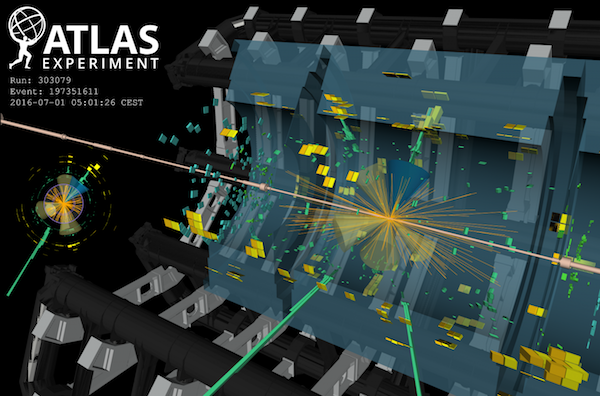
When scientists announced the discovery of the Higgs boson in 2012, it was a huge triumph for the Standard Model of particle physics, the leading theory of subatomic matter. The particle had been predicted to explain why other particles have mass. But finding this particle was not the end of its story—rather, it was a beginning. Additional measurements were needed to prove the particle scientists discovered was the same one predicted by the Standard Model and not something similar, but different. Furthermore, many details about how the Higgs works to bestow mass on other particles and why it has the properties it does remain mysterious.
Today physicists reported an important observation that could help us understand this fascinating particle and clarify the origins of the mass. Using the Large Hadron Collider (LHC), the world’s most powerful particle accelerator, located at the CERN laboratory on the French–Swiss border, scientists observed collisions that produced not only Higgs bosons, but also a top quark and its antimatter counterpart, an anti–top quark.
These quarks are the heaviest known fundamental particles and had never before been seen along with Higgs bosons as the products of a collision. I am a scientist on one of the teams behind the announcement and we are all very excited. Until these measurements we had only indirect evidence of how top quarks and Higgs bosons interact. Now we can see these dealings up close.
Mysteries of Mass
The Higgs boson was first predicted in 1964 along with an energy field—the Higgs field—that permeates the universe. When fundamental subatomic particles interact with this field, the thinking goes, they acquire mass. But interestingly, theoretical predictions suggest the Higgs boson itself should have a mass far higher than what we observe.
The reason for this is subtle. The Higgs boson’s own mass comes from two sources: one part arises directly from its interactions with the Higgs field, but there is another indirect contribution. Like all subatomic particles, the Higgs boson can briefly transform into other particles—for instance, top quarks, W and Z bosons, and even pairs of Higgs bosons. While in this fluctuated state these transformed particles can also interact with the Higgs field and indirectly contribute to the Higgs boson’s mass.
This contribution to the Higgs mass is expected to be enormous, unless the effects of the top quark and the W, Z and Higgs bosons can cancel out this mass very precisely. For now that seems unlikely (and certainly unexplained), so this presents a serious mystery. Thus, it is important to understand the interaction between Higgs bosons and top quarks to try to shed some light on this pressing conundrum.
Aside from the unanswered questions regarding the mass of the Higgs boson itself, there is another reason to be interested in the relationship between the top quark and the Higgs boson. The top quark is the particle that interacts most with the Higgs field—we know this because it is the heaviest known particle, and particles gain mass according to how strongly they deal with the field.
The intimate relationship between the top quark and the Higgs may offer us a favored route for discovering new particles in nature. Because of the mystery remaining around how the Higgs generates mass, it is entirely likely that undiscovered particles will first appear in collisions in which the Higgs field plays a prominent role. Thus, events in which the top quark and Higgs boson simultaneously appear are an attractive laboratory to investigate new physics.
Searching for a Needle in a Haystack
The new results come from two experiments operating at the LHC: CMS and ATLAS. The CMS collaboration’s findings were published in Physical Review Letters; the ATLAS team submitted their observation for publication today. Both experiments also gave presentations at the 2018 Conference on Large Hadron Collider Physics currently underway in Bologna, Italy.
Each experiment collided well over a quadrillion pairs of protons together, and recorded over a billion of these collisions. Of these, only a few hundred collisions simultaneously produced a Higgs boson and a top quark/antiquark pair. Identifying those events was extremely challenging because top quarks are produced in only 1 percent of collisions in which Higgs bosons result. Even these daunting numbers do not convey the true difficulty involved in these measurements. Both the top quark and antiquark each decay into three daughter particles and the Higgs boson decays into two.
Thus, each event of the kind reported today involved at least eight different objects. Sophisticated algorithms were needed to look at the eight objects and identify which daughter particles originated from which parent particles. This process employed complex statistical techniques, including neural networks and boosted decision trees. These measurements are truly breathtaking in terms of the intellectual effort that was needed to cut through the confusion.
The LHC will continue to collide protons through December, then will suspend operations for two years for upgrades and refurbishments for both the accelerator and its experiments. It will be turned back on in 2021, and between then and 2030 the scientific collaborations at the LHC expect to record 30 times more data than they recorded from 2011 through 2018.
The prospect of an unparalleled amount of future data make this a thrilling time for particle physicists. If there are surprises to be found in the physics surrounding the Higgs boson, the CMS and ATLAS teams will find them. Those of us who are involved in the process are incredibly excited by the discoveries the future might bring.

